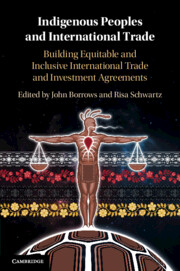 Indigenous Peoples and International Trade
Indigenous Peoples and International Trade from Part I - Indigenous Peoples and International Trade and Investment
Published online by Cambridge University Press: 11 June 2020
Chapter 5 brings the reader to the far north to examine the importance of self-determination for Inuit in trading disputes on seals and seal products. Michael Fakhri and Madeleine Redfern focus on how the Appellate Body of the World Trade Organization used trade law to construct an Indigenous exemption including a European-imposed determination of Indigenous identity for the purpose of trade in a manner that limits Inuit political and economic options and works against their rights. This chapter emphasizes the importance of Indigenous people continuing to assert their sovereign power and claims for self-determination not just through international law but, more specifically, through international trade law.
To save this book to your Kindle, first ensure [email protected] is added to your Approved Personal Document E-mail List under your Personal Document Settings on the Manage Your Content and Devices page of your Amazon account. Then enter the ‘name’ part of your Kindle email address below. Find out more about saving to your Kindle.
Note you can select to save to either the @free.kindle.com or @kindle.com variations. ‘@free.kindle.com’ emails are free but can only be saved to your device when it is connected to wi-fi. ‘@kindle.com’ emails can be delivered even when you are not connected to wi-fi, but note that service fees apply.
Find out more about the Kindle Personal Document Service.
To save content items to your account, please confirm that you agree to abide by our usage policies. If this is the first time you use this feature, you will be asked to authorise Cambridge Core to connect with your account. Find out more about saving content to Dropbox.
To save content items to your account, please confirm that you agree to abide by our usage policies. If this is the first time you use this feature, you will be asked to authorise Cambridge Core to connect with your account. Find out more about saving content to Google Drive.